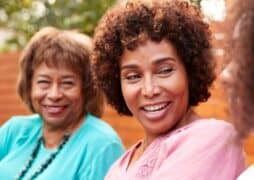
One of the most important first steps in taking charge of your breast health is understanding your breast cancer risk. Breast cancer is caused by unhealthy breast cells growing and multiplying faster than healthy breast cells, but how can we determine who is at higher risk for developing breast cancer?
As researchers have found, the answer is often a complex combination of biology and environmental factors that varies from person to person.
While everyone is at risk for breast cancer, some people are at a higher risk than others. To complicate things further, some who have few to no risk factors (aside from being born female and getting older) will develop breast cancer, while others that do have these risk factors will never develop breast cancer.
“When it comes to breast cancer risk, there really is no one size fits all,” says Komen-funded researcher Tara Ballinger, M.D. “If you look across the United States, the average risk for breast cancer is about 12%. So, one in eight women will get breast cancer, regardless of risk factors.”
While not all breast cancer risk factors are controllable, you may be able to reduce your risk by making healthier lifestyle choices. The first step is to learn more about which risk factors you can control and which ones you can’t.
Risk Factors You Cannot Change
Some risk factors associated with breast cancer cannot be changed and are determined by a person’s unique biological blueprint. These include the two most common risk factors: being born female and getting older. Other examples of unchangeable risk factors include having a personal history of cancer, a history of breast or ovarian cancer in your family, having dense breast tissue, having high bone density or a high birthweight.
There are also several genetic mutations associated with breast cancer risk; most commonly the inherited mutations in the BRCA1 or BRCA2 gene. Research is ongoing to find additional gene mutations that could affect a person’s breast cancer risk.
Certain races and ethnicities also have a higher risk of breast cancer. Women of Ashkenazi Jewish ancestry have a higher occurrence of BRCA1 and BRCA2 gene mutations, while Black women are more likely than other women to be diagnosed with aggressive cancers like triple negative breast cancer.
For those with a family history of breast cancer, genetic counseling and testing are an effective way to obtain information about their personal risk factors and those for their family.
“Most women who are living with a genetic mutation are unaware of it, so I think it’s really important for patients with any history of cancer to ask their doctors about genetic testing,” says Dr. Ballinger.
Risk Factors You Can Change
Most breast cancer risk factors that can be changed are based on lifestyle choices. Komen Scholar and medical oncologist Jennifer Ligibel, M.D., is studying how some of these factors, like obesity and diet, can impact breast cancer risk.
“We know that obesity is linked to a higher risk of developing breast cancer in postmenopausal women, but there is some evidence that shows a higher risk of triple negative breast cancer in younger women with obesity,” says Dr. Ligibel. “There’s also evidence that suggests that women who exercise more regularly, regardless of body weight, are at lower risk of developing breast cancer.”
Alcohol consumption is linked to an increased breast cancer risk, as well as smoking, menopausal hormone therapy and radiation exposure. Most sources also list reproductive history and breastfeeding as controllable risks, but we know that these choices are not always voluntary and may be out of a person’s control.
Resources to Take Charge of Your Risk
Learning more about your breast cancer risk can empower you to make important decisions about your breast health. There are many online resources, including Komen’s educational About Breast Cancer pages that describe many different risk factors for breast cancer. Komen’s Breast Cancer Risk Factors Table is another great resource where you can find lists of risk factors that are linked to breast cancer, not linked to breast cancer, and still under study.
You can also learn more about your health risks by using Komen’s My Family Health History Tool. Once you add your family’s health data and share it with your doctor, you can discuss your risk and any recommendations for reducing your risk. It can also help you look for early warning signs of disease.
“If there was one thing that a woman could do to reduce her risk of breast cancer, I think it’s really to just become empowered about what your individual risk factors are, because the things that you can do to maximize reducing your risk for breast cancer are really individual,” says Dr. Ballinger. “The main thing that you can do is advocate for yourself to get the answers to those questions.”


